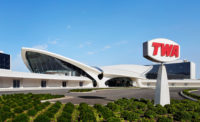Giannone Petricone Associates Gives a Long-Abandoned Victorian Hotel in Canada the Royal Treatment
Picton, Ontario

Architects & Firms
When the Toronto-based architecture firm Giannone Petricone Associates (GPA) was asked by Greg Sorbara—a former Canadian politician and finance minister—to renovate the Royal Hotel, an 1879 Victorian building he and his family had bought in Picton, Ontario, in 2013, the architects knew they had their work cut out for them. The central staircase was carpeted with moss, and, early in the planning stages, the roof caved in. “We told him he was mad,” recalls Sorbara’s son-in-law Sol Korngold, who later changed his mind and left the software business he helped found to become the Royal’s general manager. Sorbara wanted to create a gathering spot on Main Street for locals and tourists visiting Prince Edward County, an agricultural area known for its food and wine. The architects saw an opportunity to revive a historic building while adding offbeat, contemporary touches.
Pina Petricone and Ralph Giannone, the husband-and-wife team who in 1995 founded the firm—known for sleek urban towers and exuberant retail and restaurant projects, as well as sophisticated houses, furniture, and lighting—enjoy working at many different scales. The architects redesigned the existing hotel with 28 guest rooms, a café, three bars, a restaurant, spa, gym, and sauna. Outside, a redbrick garden terrace overlooks a fourth bar and a patio with a fireplace, and also leads to a swimming pool. Nearby, the hotel’s stables were turned into the Royal Annex, an “abstracted farmhouse” that contains five rooms.
GPA’s approach to the project was a mixture of conservation and innovation. The facade was landmarked from the second floor up, but the first floor had been altered. The architects restored the upper facade while recreating the front balustrades on the lower portion in expanded metal mesh.
Upon entering the lobby, the open-all-day Counter Bar is on the left. The floor and bar are white oak, as are fins at the ceiling. Beyond the bar, the marble and bronze check-in desk (upholstered in a quilted traditional floral fabric) sits on a marble mosaic “carpet” set into the oak floor. At the top of a large column, a ring of light illuminates a rippling plaster ceiling rosette, which alludes to water damage that had occurred throughout the hotel—part of the architects’ strategy of invoking “sublime decay.”

1

2
Rippling plaster encircles ceiling lights in the Parlour (1) and a column near the reception desk (2). Photos © Graydon Herriott (1), Doublespace (2), click to enlarge.
Across from the bar, the Parlour is a lobby lounge for gathering and working where a large GPA-designed cabinet houses the Convertible Bar. A fireplace surround was inspired by a starched white tablecloth, and more rippled rosettes encircle the ceiling lights. The corridor leading to the library, restaurant, and terrace has an elevator cage of expanded metal mesh like that of the facade, but brass-plated, and a zigzagging ceiling light. A photograph of the former crumbling staircase hangs at the entrance of the men’s room, while the women’s room has round mirrors perched on cast-metal duck and chicken legs.

3
Walls of dark-stained wood punctuate guest rooms (3) and the library (4), where they are given a corduroy treatment. Bathrooms feature tiles in tartan patterns (5). Photos © Doublespace

4

5
The restaurant is the formal dining spot, and its ceiling of compressed acoustical fins reinterprets a Victorian rosette as the 22-foot-diameter underside of a mushroom, a nod to the area’s agriculture. (The Sorbaras’ organic farm supplies much of the produce.)
In some guest rooms, beds have headboards framed in what the architects describe as a rectangular embroidery hoop—another Victorian reference—while tiles in the bathrooms evoke that era’s tartans in colors named after apple varieties, and a scalloped edge on the vanities refers to its linens. “A hotel should be completely transporting,” says Petricone. “To work in an existing building and bring it to life again” was a goal at which the architects more than succeeded.




